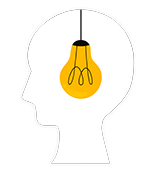Have you heard the phrase, “Not all who wander are lost?” Well, not all who are depressed feel sad. Some feel nothing or empty. They feel blah or numb. Some even feel constantly restless. Those people are experiencing what is called anhedonia. And chances are that if you’re experiencing it, you probably don’t even realize it.
Anhedonia is a word that has been in the medical literature for over a century. The term was coined back in the late 1800s by French psychologist Théodule Ribot to define the disappearance or absence of the ability to feel pleasure. While anhedonia isn’t new, it presents as a new beast in the 2020s compared to the 1890s. The DSM-V defines it specifically as “markedly diminished interest or pleasure in all, or almost all, activities.” It manifests in two ways: first, you stop seeking out fun things that used to bring you joy, and second, even when you participate in them, they don’t bring you joy. An easy way to remember what it means is to break down the roots of the word in Greek: “An” means without, and “Hedone” is pleasure, so it literally translates into a “without pleasure” or a “lack of joy.”
When you’re experiencing anhedonia, your daily goal is just getting through the day — not trying something new at that delicious Italian restaurant you’re going to with friends after work, perfecting your form on that dumbbell press at the gym, or checking in the morning to see if that beauty serum is starting to take effect. Even the joy of achieving a task like successfully executing a new recipe for the family dinner or wrapping up a report at work is robbed from us. There’s no excitement from expecting, no joy from experiencing, and no pride for executing those goals. Only self-doubt: Should I have seasoned the pork chop differently? Was the PowerPoint engaging enough? And once we’re past that, we don’t celebrate it. Instead, we’re on to the next goal. And the next. And the next.
I believe anhedonia is something that we all experience at one point in time or another. I estimate that, for moments in time, at least 95 percent of us have felt this feeling of our favorite song just not uplifting us the way it usually does, or that sitting down with a pair of knitting needles for an hour isn’t as satisfying as usual. Anhedonia quietly sneaks up on you — seemingly out of nowhere — and starts stealing all of the joy out of your life. You’re killing it at work and the pillar of strength at home, but when you reach inbox zero while everyone is out on a Saturday night leaving you home alone, you’re not satisfied with a job well done. Instead, you feel empty.
For many, anhedonia can pass as quickly as it came and it’s not an issue. It’s a problem, however, when you experience it for long stretches of time. And because people with high-functioning depression are very good at adapting to uncomfortable circumstances, we can feel this way for long periods of time without even realizing it.
I want to bring anhedonia into everyday language because there’s power in naming something. That singular act of identifying and naming how you feel makes you feel better and less scared. It’s called “affect labeling” and it’s a process of emotional regulation that research shows can help you feel less stressed. I wanted that for my patients who, increasingly over the past few years, were telling me that they weren’t enjoying things as much as they used to. They weren’t processing their emotions, so they didn’t really know how they felt. These people were busying themselves as a distraction or a way to sublimate from uncomfortable feelings. Anhedonia also helps numb those uncomfortable feelings. But not forever.
A patient of mine who was experiencing anhedonia told me a story about how she was vacuuming her living room and suddenly started screaming and crying. But as soon as she saw that was terrifying her 3-year-old daughter, who had been playing on her iPad but then started pulling on her mother’s skirt to see what was wrong, she immediately stopped crying, comforted her daughter, put away the vacuum, started making dinner for the family and went right on with her day. She never told a soul what happened until she eventually came to me for treatment of her postpartum and high-functioning depression. We can run from these symptoms and conditions, but we can’t hide from them forever.
It’s important to note that anhedonia itself isn’t a condition or a disease. It’s a symptom of a condition. Anhedonia is to depression, for example, what a dry cough and sneezing are to a cold. It’s also just as contagious, in a way. We’ve all had that angry professor, micromanaging boss, or impossible-to-please relative who overworked themselves, projected their issues onto others, and was inherently joyless. I’ve even been guilty of this in my own family. Not only was I overextended, but I signed my grade-school daughter up for so many activities, she was overextended as well. “Are you having fun?” I asked her once. “I’m OK,” she said, without any emotion in her voice.
That lack of feeling can so easily be spread to family members, colleagues, or friends who constantly interact with the anhedonic person. They normalize “blahness” with every interaction they have. After my daughter gave me that ambivalent response, I decided that if she’s not passionate about an activity, we put a pause on it and pour into ones she does feel passionate about. The treatment for anhedonia is to be present and do things you once loved full attention. As it turned out, a few months after I pulled her out of swimming, she mentioned that she wanted to go back to the pool and that she missed her teacher. That’s how I knew it was time to sign her up again.
Not to scare you, but some of the most common conditions associated with anhedonia range from psychiatric disorders like schizophrenia to neurodegenerative disorders like Alzheimer’s and Parkinson’s to substance-use disorders. People in the autistic community, for example, may display anhedonia because their decision-making process is less influenced by rewards. And when someone, for example, has a substance they’re dependent upon, they eventually stop getting pleasure out of using it. It doesn’t give them the same high that it did at first. So why do they keep going back to it? Because they’re trying to get that feeling back.
Anhedonia is symptomatic not only of high-functioning depression but post-traumatic stress disorder as well. That’s one of the reasons I’ve spent so much time covering the impact that trauma has on people with high-functioning depression. It’s all connected.
When you try to think about when you started to feel anhedonic, try to locate the point in time when you first experienced trauma. That’s probably when you stopped prioritizing play. That’s when you went from being in your feelings to feeling nothing. And that’s when you stopped filling your cup with joy. So, your capacity for joy hasn’t disappeared — it’s just waiting for you to create the space to welcome it back in.
Adapted excerpt from High Functioning by Dr. Judith Joseph. Copyright © 2025 by Dr. Judith Joseph MD MBA PC. Used with permission from Little, Brown Spark, an imprint of Hachette Book Group.









